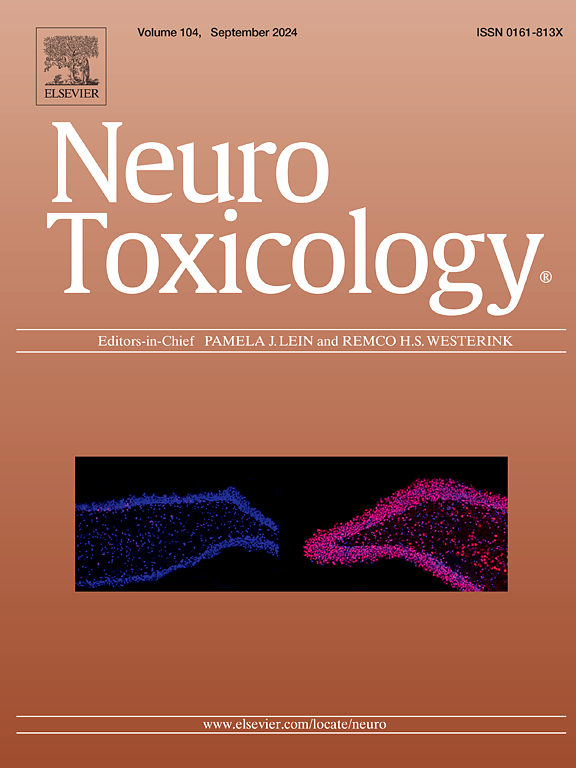载菊酸脂质体纳米颗粒对alcl3诱导的大鼠神经毒性的神经保护作用:AMPK/AKT/Nrf-2信号通路的作用
IF 3.9
3区 医学
Q2 NEUROSCIENCES
引用次数: 0
摘要
铝(Al)是人们在日常生活中通过食物、饮用水和药品接触到的主要有害金属。本研究的目的是评估载菊苣酸脂质体纳米颗粒(CA纳米颗粒)对氯化铝(AlCl3)诱导的大鼠神经毒性的潜在神经保护作用。采用薄膜水化法制备的CA纳米粒子平均粒径为146.3 nm, PDI为0.377,zeta电位为- 41.8 mV,具有良好的稳定性。32只雄性Sprague-Dawley大鼠被分为四组。对照组给予生理盐水,对照组给予AlCl3(70 mg/kg/day p.o),连续5周,CA纳米颗粒组分别给予5、10 mg/kg/day p.o,连续5周,注射AlCl3后1 h。进行行为测试,包括开放场和新对象测试,并在实验结束时分析脑组织的生化、分子、组织学和免疫组织化学变化。与AlCl3相比,CA纳米颗粒(10 mg/kg)改善了行为障碍,降低了脑内乙酰胆碱酯酶活性、谷氨酰胺、丙二醛、肿瘤坏死因子- α和白细胞介素-6的水平,提高了脑内谷胱甘肽、核因子红细胞2相关因子2 (Nrf-2)、AKT信号通路和amp活化激酶(AMPK)的表达水平。此外,CA纳米颗粒(10 mg/kg)改善了组织病理学改变,恢复了胶质原纤维酸性蛋白的免疫组织化学评分和Beclin的表达。这些发现表明,CA纳米颗粒(10 mg/kg)在AMPK/AKT/Nrf-2通路中发挥重要作用,这是其抗氧化和抗炎alcl3诱导的大鼠神经毒性的原因。这些发现为未来的研究铺平了道路,探索CA纳米颗粒在其他神经退行性模型中的潜力,优化其配方以增强大脑靶向性,并推进其作为治疗策略的临床转化。本文章由计算机程序翻译,如有差异,请以英文原文为准。
Neuroprotective effect of chicoric acid-loaded liposome nanoparticles against AlCl3-induced neurotoxicity in rats: Insights into the role of AMPK/AKT/Nrf-2 signaling pathway
Aluminum (Al) is the primary hazardous metal that individuals are exposed to in their daily lives via food, drinking water, and pharmaceuticals. The aim of this study was to evaluate the potential neuroprotective effect of chicoric acid-loaded liposome nanoparticles (CA nanoparticles) on aluminum chloride (AlCl3)-induced neurotoxicity in rats. CA nanoparticles were prepared using the thin-film hydration method, yielding nanoparticles with an average size of 146.3 nm, a polydispersity index (PDI) of 0.377, and a zeta potential of −41.8 mV, ensuring good stability. Thirty-two male Sprague-Dawley rats were allocated into four groups. The control group received saline, the control positive group was given AlCl3 (70 mg/kg/day p.o.) for 5 weeks, and the CA nanoparticle groups were given 2 doses (5 and 10 mg/kg/day p.o.) for 5 weeks, one hour after the injection of AlCl3. Behavioral tests, including open field and novel object tests, were conducted, and brain tissues were analysed for biochemical, molecular, histological and immune-histochemical changes at the end of the experiment. Compared with AlCl3, CA nanoparticles (10 mg/kg) improved the behavioral impairments and reduced the brain levels of acetylcholine esterase activity, glutamine, malondialdehyde, tumor necrosis factor-alpha, and interleukin-6 and increased the brain glutathione, nuclear factor erythroid 2-related factor 2 (Nrf-2), AKT signaling pathway, and AMP-activated kinase (AMPK) expression levels. Additionally, CA nanoparticles (10 mg/kg) improved histopathological changes and restored the immune-histochemical scores of glial fibrillary acidic proteins and the expression of Beclin. These findings revealed that CA nanoparticles (10 mg/kg) play a crucial role in the AMPK/AKT/Nrf-2 pathway, which is responsible for their antioxidant and anti-inflammatory effects against AlCl3-induced neurotoxicity in rats. These findings are paving the way for future investigations exploring the potential of CA nanoparticles in other neurodegenerative models, optimizing their formulation for enhanced brain targeting, and advancing their clinical translation as a therapeutic strategy.
求助全文
通过发布文献求助,成功后即可免费获取论文全文。
去求助
来源期刊

Neurotoxicology
医学-毒理学
CiteScore
6.80
自引率
5.90%
发文量
161
审稿时长
70 days
期刊介绍:
NeuroToxicology specializes in publishing the best peer-reviewed original research papers dealing with the effects of toxic substances on the nervous system of humans and experimental animals of all ages. The Journal emphasizes papers dealing with the neurotoxic effects of environmentally significant chemical hazards, manufactured drugs and naturally occurring compounds.
 求助内容:
求助内容: 应助结果提醒方式:
应助结果提醒方式:


